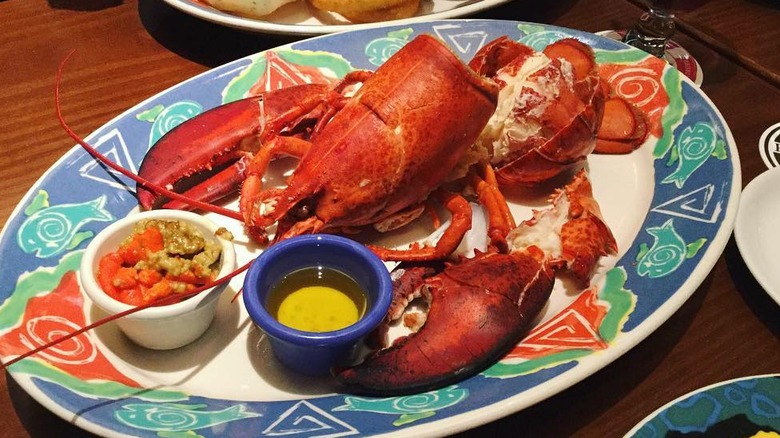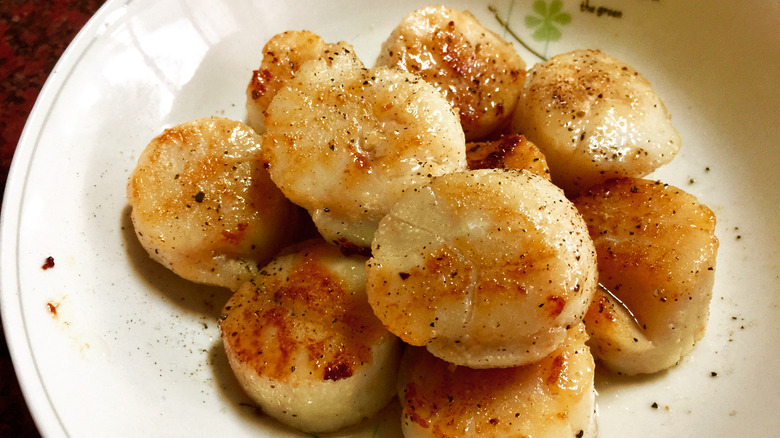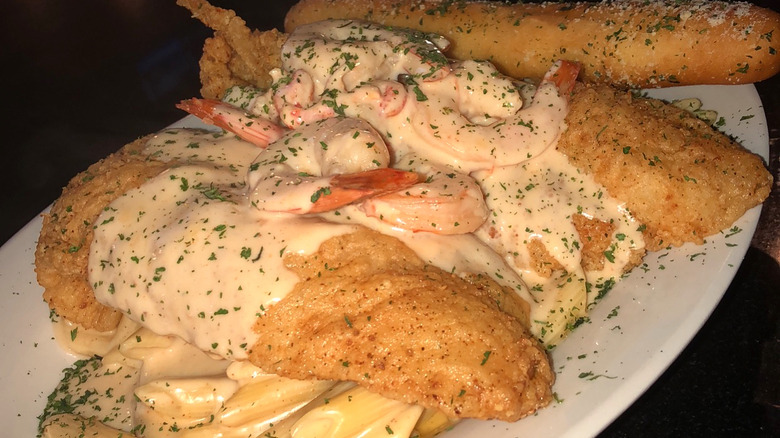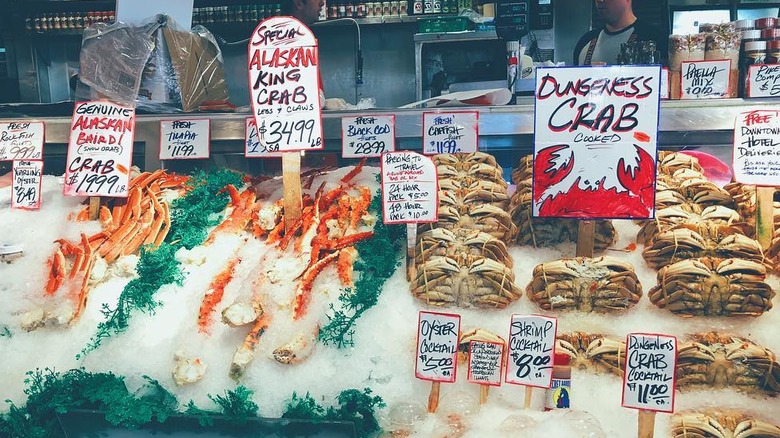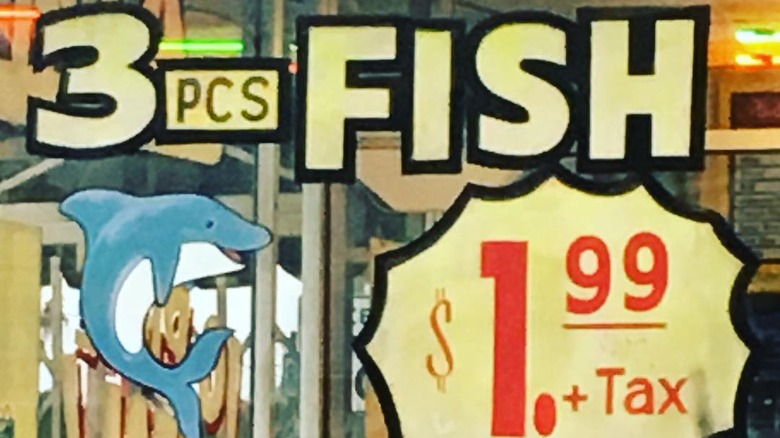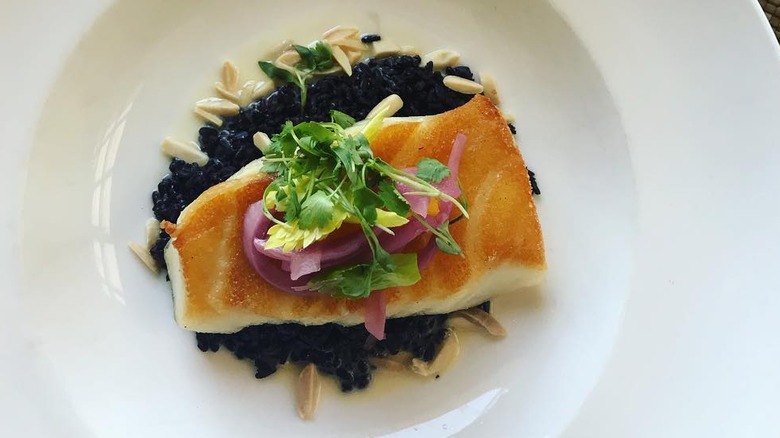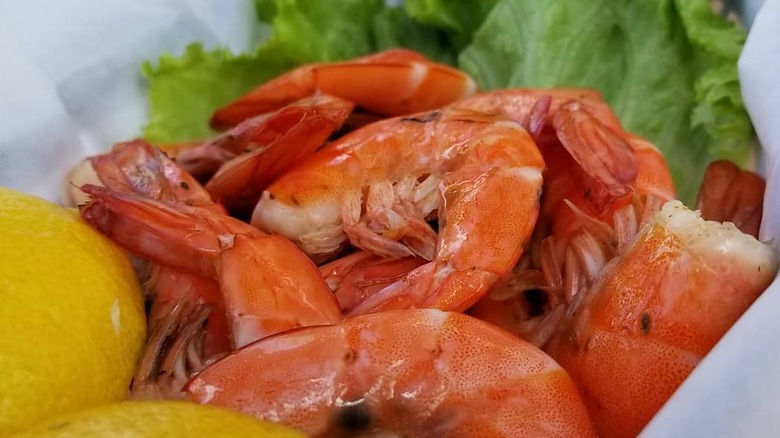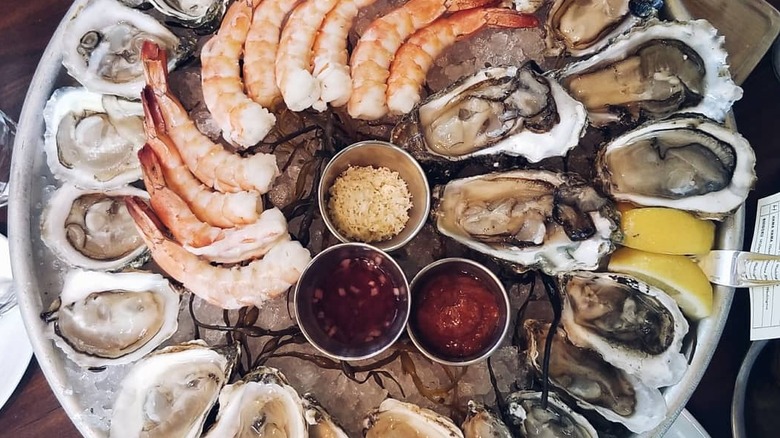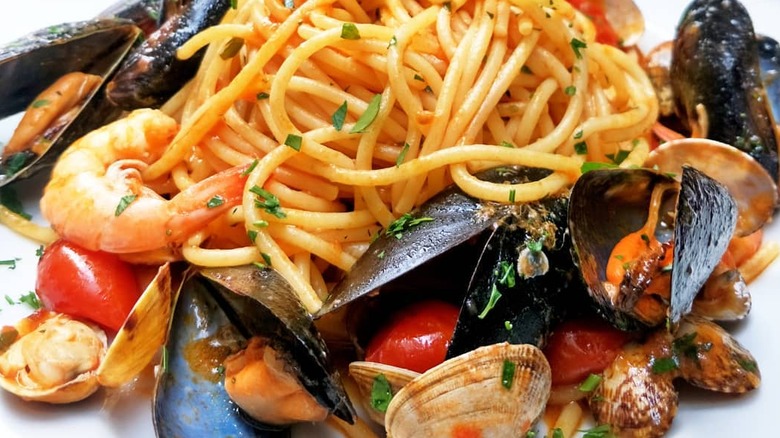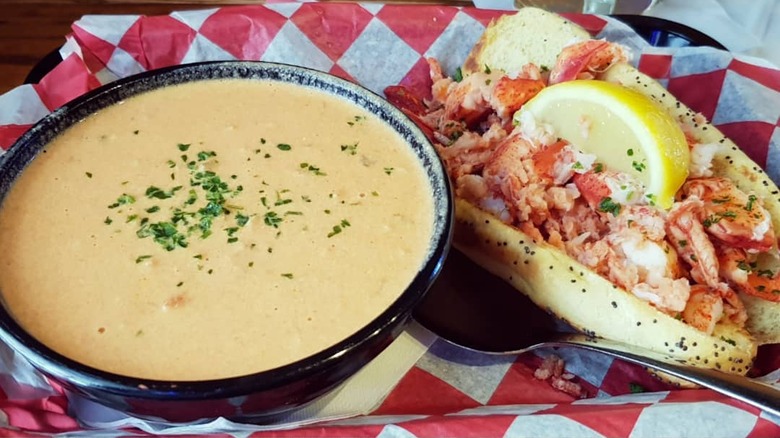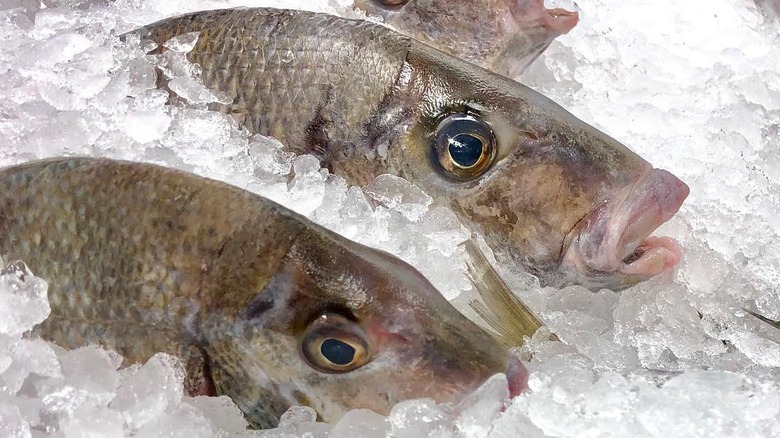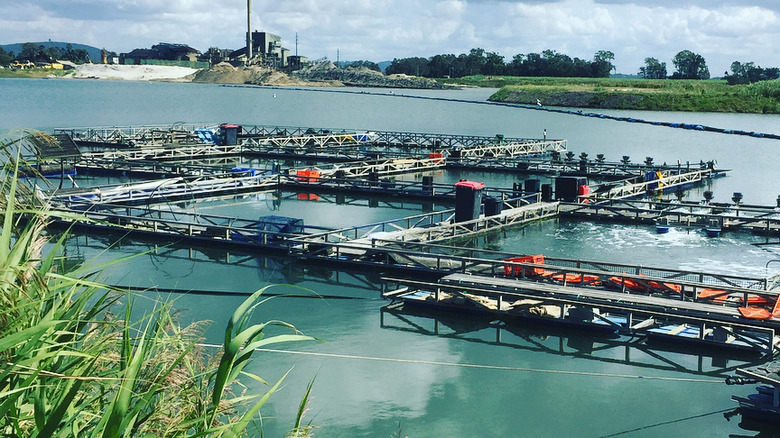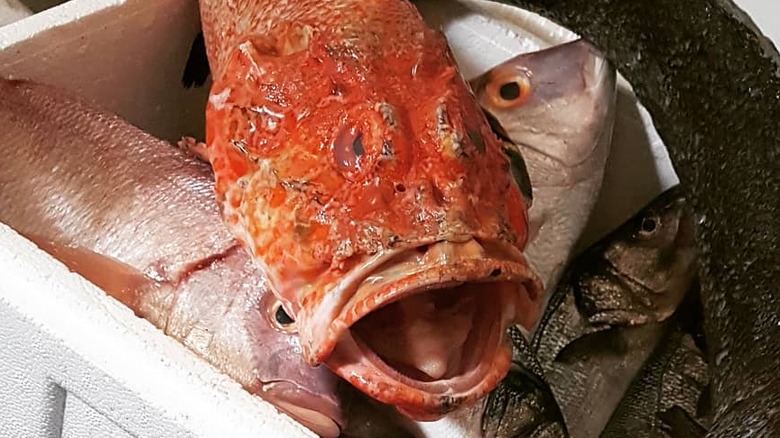Signs You're At A Fake Seafood Restaurant
A nice seafood dinner can be a great treat for many, but it definitely comes at a price. Why is seafood so expensive? A lot of it has to do with where the fish or shellfish comes from, how it's caught, the species' populations size, and the time of year it's available. So when you're "shelling" out big bucks for broiled lobster, or a few nice cuts of sashimi, it's important to know you're not getting lured into a bait and switch situation.
According to Nation's Restaurant News, consumers want more seafood options. That's great for fishing industries, but is the menu at Red Lobster really as good as what comes fresh off the boat in coastal Maine? Seafood fraud is no joke, but even the savviest of seafood fans can get scammed by "market prices." Avoid getting shell-shocked with these surefire ways that show you're dining at a fake seafood restaurant.
The scallops are very uniform in size and shape
Scallops are highly-desired in seafood restaurants, and often fetch a high price. That's because harvesting scallops is a very involved process. According to SeaGrant Maine, most scallops are collected from drag boats, or handpicked by SCUBA divers. Fresh scallops tend to spoil quickly, so many places opt to get them frozen; when thawed however, this mollusk tends to have a chewy texture. Enjoying this high-maintenance seafood at the peak of freshness is not cheap, so knowing how to spot phony scallops is key.
Your scallops should taste perfect — but they shouldn't look perfect. "Millions of people paying good money for scallops are actually eating cheap stingray, skate, or shark that has been sectioned up by a cookie cutter to look like scallops," says Dr. David Friedman, author of the book "Food Sanity." He goes on to explain, "Sometimes surimi (fish paste) is used to resemble a scallop. This fish paste is a compilation of cheap pacific whiting fish and pollock with added starch, sugar, artificial flavors, MSG, and preservatives." They also shouldn't smell ... fishy. Dan Sweeney, owner of Matt's Cape House, told CTPost that scallops are a "naturally 'gassy' smelling food ... so you can expect a little smell. But you shouldn't be able to detect it without a fairly close-up sniff, and it shouldn't smell like something has spoiled."
The dishes are overcomplicated with creamy sauces, breadings, or deep fried
Seafood scampi that's drowning in alfredo sauce? Fish that's so deep-fried it's all crunch? Fresh seafood is so good on its own, it doesn't need heavy sauces, seasonings, or heaps of breadcrumbs to make it better. A hefty fried fish menu is also a pretty blatant indicator that the dishes you're chowing down on are less-than-fresh. In an article for Thrillist, Jonathan Gill, executive chef at Portland, Oregon's RingSide Fish House, states, "If I went to a seafood restaurant and all the fish was fried, then you know it probably came in frozen."
Chef Matt Ginn of EVO Kitchen + Bar in Portland, Maine recommended diners "look for simple dishes that let the product shine" in an article for Today.com. This is especially true when it comes to lobster. He adds that, "the amazing sweetness that sets a Maine lobster apart from some of its shellfish brethren is subtle and should be eaten with sauces and dressings that complement the meat, not overpower it." Swim fast away if broiled, buttered, seared or sautéed dishes are not on offer.
Items are listed at Market price
"Market price" on a menu often indicates an expensive item — but mostly, seafood restaurants are banking on the fact that you're not scouring seafood markets to figure out the actual price. This is a tactic lots of restaurants use to squeeze more cash out of customers, but it's not completely fair or accurate. "Traditionally, restaurants employ the listing to denote fresh-caught seafood," writes Katie Krader, in an article for Bloomberg. "The cost of a fish or lobster can be wildly variable based on the size, the season, and other factors affecting supply."
That may be true, but under most circumstances, the price of certain seafood items tends to level out, rather than fluctuate, across the season. Trey Foshee, chef and co-owner of George's at the Cove, admits that "even seafood prices don't change too quickly ... Local yellowtail goes from $3 pound in the summer to $6 pound in the winter, depending on where the fish are coming from. All summer you might see a variance of 50 cents a pound—that would not make me change my menu price." It may be real seafood, but there's a good chance they're giving you a fake market price.
Or the prices are too good to be true
If a menu offers premium seafood items, like red snapper, grouper, or king crab, at shrimp cocktail prices, watch out — you'll get what you pay for. Even inexpensive fish like tilapia is sold based on supply and demand. A low price for lobster, or a "catch of the day" sold in a place that doesn't actually catch their fish each day, indicates something isn't quite right.
According to Patrick Allen's article on Lifehacker, "if something about the fish seems fishy, press the chef or fish seller for information. They should be able to tell you what the fish is, where it came from, and answer any other questions you have." If they won't let you off the hook, seek out a different option. And avoid that "Monday special" altogether — celebrity chef Anthony Bourdain points out in his book, "Kitchen Confidential: Adventures in the Culinary Underbelly," that "unless you're dining at a restaurant on the coast or an upscale place known for seafood, there's a chance that your Monday fish special at the dive bar down the road could include fillets that are four days old."
The way the fish is categorized seems...fishy
There are plenty of fish in the sea, but some are also farmed, some are caught in lakes or other freshwater sources ... these characteristics might take a lot of work to memorize, but these details can make or break your seafood dining experience. The Environmental Defense Fund urges fish eaters to examine the labels, wherever possible. Is "farmed Chilean seabass" on the menu? Steer-clear, that's not a fish that can be tamed (it's only caught in the wild). And if your Atlantic salmon has "wild" attached to the front, you're in big trouble: that kind of fish happens to be an endangered species, and is generally not for legal sale.
It's possible that some restaurants may think certain buzzwords will make their meals sound more appealing, and honestly don't know these characteristics are inaccurate (in which case, they have bigger fish to fry...). Have a sneaking suspicion your seafood item is not categorized correctly? Check out the website for the National Oceanic and Atmospheric Administration. Chances are if a fish comes with a ton of adjectives or qualifiers, it's the restaurant's way of trying to distract you from a bigger issue with your meal.
Or the label is a complete lie
Are those New Zealand mussels REALLY from New Zealand, or is it just a ploy to elevate the restaurant's lackluster seafood options? This type of fish fraud is surprisingly common and can result in a super low quality meal at a high price. In an article for Forbes, Larry Olmsted discusses how shrimp, one of the most highly consumed types of seafood, is rarely ever represented accurately on menus.
According to Olmsted, "Gulf" shrimp appears on a lot of labels and implies that the shrimp in your cocktail is sourced from straight from the Gulf of Mexico. But in reality, the majority of shrimp diners consume is farmed. Olmsted notes that, "on the worldwide shrimp market, wild caught shrimp from the Gulf of Mexico routinely command the highest prices" — which should be an indicator right away that the source of your shrimp might be questionable if it happens to be inexpensive. Rock shrimp and Ruby Red shrimp are two other kinds that are typically rare and difficult to harvest; if you see them on a menu somewhere outside of Florida and Alabama, you're likely just eating an overpriced import.
Items on the menu aren't seasonal
Beef and chicken are readily available all year long, but seafood is definitely seasonal. And similarly to fruits and vegetables, seafood tastes best when you're eating it at the peak of maturity. While it's possible to find oysters all year round, the best will definitely coincide with its natural life cycle. According to Erin Shaw's research for an article in The Island Packet, in South Carolina, "local oysters are most available in fall and winter. If they're on the menu in the summer, they didn't come from here."
Knowing which season seafood is freshest, especially in comparison to the place you're eating it in, will help you spot outright scams. You don't have to memorize the lifecycle of a fish though. Calendars like the one found on the Seattle Fish Co. website can be a helpful guide. Does the menu abound with Mahi Mahi in the summer? Soft shell crabs in the dead of winter? Hold off on ordering — it'll be worth the wait when the right time rolls around.
Pasta dishes are a major feature
If you're at a real seafood restaurant, pasta shouldn't be the main event. Menus laden with carbo-loaded dishes — like linguine with clam sauce, shrimp scampi with angel hair pasta, lobster ravioli, or seafood risotto — are surefire red flags that the restaurant is trying to compromise for its freshness. According to an article on Oola, the pasta at Red Lobster is microwaved in plastic bags. That's not a pretty picture when you're forking over double digits for a nice meal out.
Plus, there's major markup on that bowl of penne. According to Anne Prior's research for article on Market Watch, "the profit margin on a pasta dish can be up to 20 percent higher." Pasta is cheap to begin with, so what looks like a less-expensive option is comparatively more expensive than if you were to just order a seafood dish at full value. Ordering a seafood pasta means that restaurants can load up your plate with noodles, top it with a few pieces of shrimp or a couple of mussels, and save the bulk of seafood ingredients for more expensive meals.
The lobster isn't actually lobster
Lobster mac 'n cheese is delicious, but dig deeper into your dish and you might discover there's barely any lobster at all. In 2016, Inside Edition tested lobster dishes from 28 well-known restaurants. According to an article on their website, "it emerged that in 35 percent of the samples, the lab found cheap substitutes instead of lobster." Many restaurants, including Red Lobster, will substitute langostino, which "looks like cooked shrimp meat but has a sweet, delicate flavor more like lobster or crab" according to SeafoodSource.com. It's smaller, cheaper, and the average customer can't tell the difference. It's still tasty, but diners may be paying extra for something that's not actually lobster.
Common dishes that use langostino include lobster bisque, lobster mac 'n cheese, and lobster salad. Several restaurants in the Inside Edition investigation were also found to use seafood mixtures for their lobster salad (containing whiting and pollock in addition to, or in place of, lobster meat). The publication was also informed by the FDA that "soup with only langostino cannot be called lobster bisque." Bottom line: if a premium product shows up on a less-than-premium menu, (aka a lobster roll served at a hot dog stand), it's probably not genuine.
The majority of the food is frozen
Unless you are eating seafood right off of the boat it was caught with, the day it was caught, most likely your meal is imported from a separate destination. A majority of fish is flash frozen, meaning it's frozen to preserve freshness shortly after it's been caught. According to Wise Geek, "fishing boats often use flash freezing to keep their catch as fresh as possible, especially if they are working in remote areas and will not be reaching port for days or weeks. In these cases, the fish are cleaned and then frozen as they are caught, and when the hold is full, the fish are offloaded for sale." This common method is safe for consumers, and allows for the nutrients of the fish to remain intact, according to the Washington Post.
That doesn't necessarily mean a restaurant should only serve frozen seafood. A seafood restaurant that takes pride in their product will make an effort to provide fresh-caught fish, every day. Landlocked? Seek out the places that go the extra mile, like Voyager in Detroit, Michigan. According to the Detroit Metro Times, the restaurant relies "on a combination of dry ice and overnight shipping to ensure the freshness of its product ... The smallest of its suppliers is said to pack the mollusks in an Igloo cooler, along with reused two liters filled with ice, then wrap it in duct tape and send it off for next-day delivery."
Or farmed
Farmed seafood is another way restaurants are able to offer customers a selection of dishes they normally wouldn't be able to purchase outside of a certain season, or at all, based on where they are located. According to the National Oceanic and Atmospheric Administration's website, "aquaculture" is a process involving "the breeding, rearing, and harvesting of animals and plants in all types of water environments." When regulated, seafood from these farms is completely fine to eat. In fact, according to NPR's The Salt, it could possible even save the world.
However, aquaculture has been problematic for quite some time due to unsavory practices that seem to go undetected, especially concerning fisheries abroad. An article in the Tampa Bay Times found that "farmed salmon are fed pellets made out of fish oil and smaller fish, ground-up chicken feathers, poultry litter (yes, that's poop), genetically modified yeast, soybeans and chicken fat" — not exactly "fish food." The article also discusses how fish farms create a heavy amount of pollution from fish excrement, as well as ethical concerns on the treatment of the fish and how they are raised. If you aren't sure, ask the restaurant where they source their seafood from; if they dodge the question, check out FishChoice's Sustainable Seafood Finder, and make a reservation elsewhere.
It's literally fake
Fish fraud is an incredibly real issue that costs consumers in the end. It all boils down to the fact that the fish you think you're ordering and eating is being grossly mislabeled by distributors. Newsweek reported on a study conducted by Oceana, an organization whose main goal is "focused solely on oceans, dedicated to achieving measurable change by conducting specific, science-based campaigns." The results of the study were shocking, to say the least. Newsweek reported that "on average, the percentage of seafood mislabeled has hovered around 30 percent for the past decade," and that "Asian catfish, a white-fleshed fish, serves as an impostor for 18 different kinds of more expensive fish, from perch to grouper."
Spotting the difference between white tuna or escolar, a fish that's commonly labeled as the former, can be hard to spot in your sushi. Luckily, changes are slowly being made, everything from stricter governmental regulations, to computerized tracking systems to ensure that everything is accurate from ship to shore. Your best bets for avoiding scams, fraudulent food, and fake seafood restaurants in general? Brushing up on seafood seasonality, understanding what market value really is, and dining locally.
